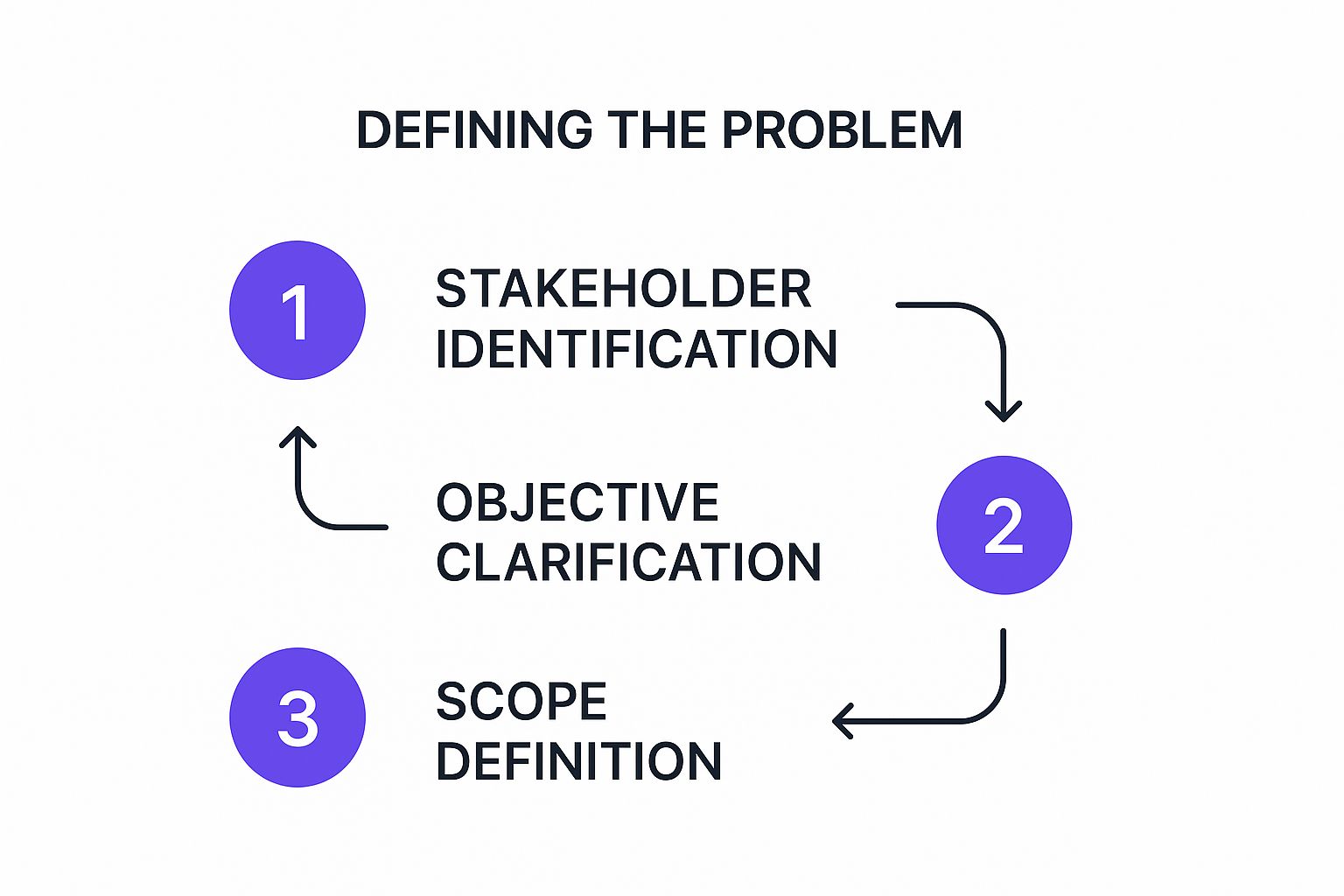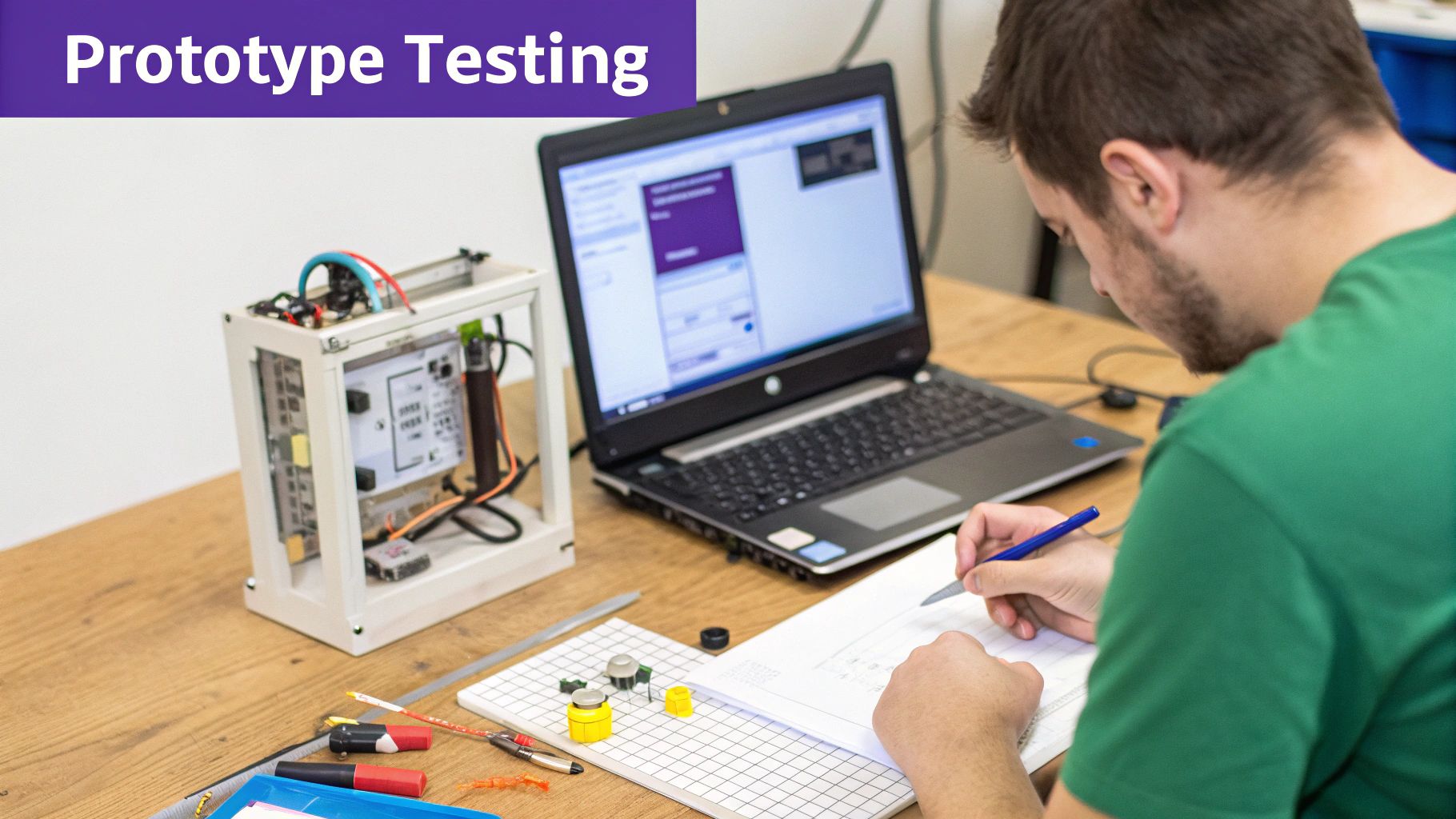Forget the myth of the lone genius waiting for a lightbulb moment. True creative problem solving isn't about luck; it's a structured process, a skill you can learn and master. It’s a reliable way to move from a foggy problem to a brilliant, practical solution.
Beyond the Lightbulb Moment
Most of us have been taught to see creativity as some mysterious force that strikes out of the blue. But here’s the good news: that's not how it works. The creative problem solving process is actually a systematic framework that turns innovation from a game of chance into a dependable practice. It gives you and your team a clear roadmap to follow, ensuring that great ideas aren't just stumbled upon—they're intentionally built.
This isn't a new concept. The approach traces its roots back to the 1950s with the Creative Problem Solving (CPS) model, pioneered by ad-man Alex Osborn and academic Sidney Parnes. What started as a way to formalize brainstorming has since grown into a powerful four-phase model that has shaped creativity training worldwide for over 70 years. Their work moved us from simply hoping for ideas to actively generating them.
Defining the Problem Space
Before you can even think about a solution, you have to get your hands dirty and truly understand the problem. This means going way beyond a surface-level glance. You need to dig deep into the context, figure out who’s involved, and nail down what a "win" actually looks like. Getting this part right is everything.
For a deeper dive, check out our comprehensive guide on creative problem solving.
The image below breaks down the essential flow of defining your problem—from figuring out who the key players are to clarifying what success truly means.

As you can see, building a clear problem definition is a step-by-step journey. It makes sure all the creative energy that follows is pointed in the right direction.
A problem well-defined is a problem half-solved. I've seen more innovative projects fail from rushing this stage than any other reason. You end up with a brilliant solution to the wrong challenge.
To give you a bird's-eye view, the creative problem solving process is built around four core phases. Each one has a distinct goal that moves you closer to the finish line.
The Four Core Phases of Creative Problem Solving
This table breaks down the entire journey, from initial confusion to a clear, actionable plan.
| Phase | Primary Goal | Key Activities |
|---|---|---|
| Clarify | Understand the true challenge | Gathering data, asking "why," defining scope |
| Ideate | Generate a wide range of ideas | Brainstorming, brainwriting, SCAMPER |
| Develop | Refine and strengthen solutions | Prototyping, getting feedback, creating plans |
| Implement | Put the best solution into action | Executing the plan, monitoring results |
Think of these phases as your guideposts. They provide the structure you need to explore possibilities freely without getting lost.
Clarifying Your Challenge to Find Real Opportunities

The quality of your solution is directly tied to how well you understand the problem. It’s so easy to jump straight into brainstorming solutions, but if you haven’t truly grasped the core challenge, you’re just setting yourself up for wasted time and effort. This first stage is all about moving from a vague sense of frustration to a clear, actionable opportunity.
Too many teams get stuck treating symptoms instead of the root cause. Let's say you see "low user engagement" in your analytics. That’s not the problem—it’s just a symptom. A well-defined challenge digs much deeper and asks why engagement is low in the first place.
Getting this clarity is absolutely essential, especially in complex areas like brand strategy services, where a fuzzy understanding of your market position leads to strategies that fall flat. Without a sharp focus, even the most brilliant ideas will miss the mark.
Digging for the Root Cause
So, how do you get past those surface-level symptoms? You need a practical way to unearth what’s really going on. One of my go-to methods is the "5 Whys." It's deceptively simple but incredibly powerful for drilling down to the heart of an issue.
Let’s stick with our "low user engagement" example to see it in action:
- Why is our user engagement low? Because new users aren't finishing the onboarding tutorial.
- Why aren't they finishing it? Feedback shows they think it’s too long and boring.
- Why is it too long and boring? We tried to explain every single feature right from the start.
- Why did we explain every feature? We were afraid they wouldn't discover a key function on their own.
- Why were we so afraid of that? Because we haven't pinpointed the one "aha" moment that truly hooks a new user.
Just like that, the problem transforms. It’s no longer a vague "low engagement" issue. The real challenge is: "We need to identify and build our onboarding around a single, powerful user benefit." Now that is a problem you can sink your teeth into.
Reframing Challenges into Opportunities
Once you’ve got a handle on the root cause, the next move is to reframe it in a way that sparks action. The "How Might We…?" (HMW) technique is perfect for this. It takes that sticky problem statement and turns it into an open-ended question that practically begs for ideas.
The way we frame a problem determines which solutions we can see. Changing the frame can transform a seemingly impossible obstacle into an exciting opportunity for innovation.
Taking our newly defined problem, we can reframe it as: "How Might We redesign the onboarding to deliver the 'aha' moment in the first 60 seconds?" See the difference? This phrasing is optimistic and solution-focused, creating the perfect launchpad for a productive brainstorming session.
This structured approach to clarification isn’t just a nice-to-have; it's proven to get better results. Research shows a strong link between how well a problem is defined and how original the final solution is. The more deliberate you are in these early steps, the more creative your outcomes will be. This shows that the creative problem solving process is a skill you can build, not just something you're born with.
Generating Ideas That Break the Mold

Now that you've got your problem clearly defined, it's time to let the ideas fly. This is where the creative problem solving process shifts gears from tight analysis to wide-open, imaginative thinking. And there's one golden rule here: separate idea generation from evaluation. Nothing shuts down creativity faster than judging ideas the moment they’re shared.
Your objective isn't to land on the perfect idea right out of the gate. Think quantity over quality. You're building a massive pile of concepts—some practical, some a bit out there, and some downright absurd. This collection is the raw clay you'll sculpt into a truly original solution.
I've seen it happen time and again: a team's biggest breakthrough often comes from an idea that was first laughed off as silly or impossible. That's why psychological safety is so crucial. Everyone on the team needs to feel safe enough to voice a half-baked thought or a wild suggestion without getting shot down. We see this with our Bulby clients all the time—the moment they commit to deferring judgment, the quality and sheer number of ideas skyrocket.
Beyond Traditional Brainstorming
The classic "everyone shout out ideas" approach to brainstorming has its place, but it's flawed. It often lets the loudest or most senior person dominate the conversation, which can easily lead to groupthink. To get a truly diverse set of ideas, you need to be a bit more deliberate.
Here are a few techniques that work wonders:
- Brainwriting: This is a silent but powerful method. Everyone jots down ideas on sticky notes or a shared digital space like Miro. After a few minutes, you pass your notes to someone else, who then adds to or builds upon your initial thoughts. It's a fantastic way to make sure every single voice is heard.
- Reverse Brainstorming: This one flips the script. Instead of asking, "How do we solve this?" you ask, "How could we cause this problem?" or "How could we make things even worse?" It sounds counterintuitive, but thinking about how to create failure is a surprisingly effective way to uncover roadblocks and innovative solutions.
- SCAMPER: Think of this as a creative checklist. It’s an acronym for seven prompts: Substitute, Combine, Adapt, Modify, Put to another use, Eliminate, and Reverse. Running your problem through these filters forces you to look at it from angles you would have never considered otherwise.
The real magic happens when you give your team permission to be unconventional. The "best" idea rarely emerges fully formed. It's usually a combination of several different thoughts, refined and built upon over time.
For more hands-on approaches, exploring a few creative thinking exercises for teams can be a great way to shake things up. These structured activities are designed to break ingrained thought patterns and help your team see the problem in a new light.
Fueling a Culture of Creativity
Ultimately, a successful ideation session comes down to the environment you foster. When people feel genuinely supported and encouraged, they’re far more willing to take creative leaps. This is doubly true for remote teams, where you need clear facilitation and the right tools to build that sense of trust and open participation.
Remember, every single idea has value at this stage. Even the ones that seem completely off the wall can be a stepping stone to something brilliant. Your job is simply to gather as much creative fuel as you can. You'll have plenty of time to sort, refine, and shape it in the next phase. So, for now, embrace the chaos and get ready for a breakthrough.
Turning Great Ideas Into Real Solutions
After the wild, anything-goes energy of brainstorming, it's time to shift gears. You’ve got a mountain of ideas, which is fantastic, but now you need to find the real diamonds. This is where we move from expansive, “what if?” thinking to a more focused, “what works?” mindset.
It’s less about hacking away at your list and more about carefully cultivating the most promising concepts. We need a way to look at our ideas with a clear, objective eye, turning gut feelings into a structured decision-making process.
From a Jumble of Ideas to a Clear Shortlist
It’s so easy to just pick the idea that feels right or the one that’s loudest in the room. A much better way to go is to measure your concepts against a set of criteria you’ve all agreed on beforehand.
The Criteria Matrix is a brilliant, low-tech tool for this. Think of it as a simple scorecard for your ideas. You rate each one against the factors that are truly important for your project’s success.
Your criteria might include things like:
- Feasibility: Can we actually pull this off with the team, budget, and time we have?
- Impact: How well does this really solve the problem we set out to fix?
- Cost: What’s the price tag on bringing this idea to life?
- Alignment: Does this fit with our company’s bigger picture and brand identity?
Give each idea a score—say, from 1 to 5—for every criterion. When you add it all up, you get a total score for each concept. This simple step helps strip out personal bias and gives you a data-backed starting point for a real conversation. Suddenly, you're not debating opinions; you're discussing the numbers.
For a deeper dive into structuring these conversations, you can explore more collaborative problem solving steps that fit perfectly into this evaluation phase.
The most creative idea in the world is worthless if you can't actually build it. This is the stage where imagination has to shake hands with reality. You're grounding those brilliant thoughts in practical, concrete steps so they can make a genuine impact.
Making Good Ideas Even Better
Once you have a handful of top contenders, it’s time to polish them up. The PPC (Positives, Potentials, Concerns) framework is a fantastic way to give feedback that builds ideas up instead of tearing them down. It’s designed to be constructive and keep the momentum going.
For each shortlisted idea, your team works through three questions:
- Positives: What do we love about this idea just as it is?
- Potentials: What could this idea become? What new opportunities could it open up?
- Concerns: What questions or obstacles do we need to figure out to make this work?
This technique changes the entire dynamic. Instead of just pointing out flaws, you’re collectively figuring out how to overcome challenges. It’s not about what’s wrong; it's about how to make it right.
This solution-focused approach mirrors a big shift in how innovative teams tackle problems today. In the past, problem-solving was often a straight line. But designers started popularizing a new method in the 20th century: generate a ton of options first, then critically refine the best ones. This is the foundation of how so many of us innovate now.
For really complex problems, you might even borrow from approaches like the Agile methodology. It’s built on a cycle of testing, feedback, and constant improvement. You can turn a promising concept into a bulletproof solution by running small experiments and building prototypes before going all-in.
Avoiding Common Pitfalls in the Creative Process

Even with a perfect roadmap, the journey of creative problem-solving can hit some serious bumps. It's rarely the process that fails; it's the very human tendencies that sneak in and derail our best efforts. Knowing what these pitfalls look like ahead of time is your best defense.
One of the most common hurdles I see is analysis paralysis, especially during the early clarification stage. Your team gets so caught up in researching and defining the problem that you get stuck. You're constantly digging for one more piece of data, one more insight, and you never actually move on to solving anything. The fear of missing something prevents you from making any progress at all.
Then there's groupthink, the quiet assassin of brainstorming sessions. This is what happens when everyone starts nodding along with the most vocal person in the room just to keep the peace. Suddenly, all those unique, brilliant perspectives your team members have are buried under a desire to conform. You wanted a brainstorm, but you got an echo chamber instead.
Sidestepping Creative Roadblocks
The good news is you can build defenses against these issues right into your workflow. To head off analysis paralysis, for example, you can set a hard deadline for the research phase. Decide as a team what "good enough" looks like and agree to move forward once you hit that mark.
Tackling groupthink requires a bit more intention. You need to create an environment where different opinions aren't just tolerated but are actively encouraged. Here are a few ways to do that:
- Assign a Devil's Advocate: Make it someone's official job to poke holes in the prevailing opinion. When challenging the group is part of the role, it feels less like a confrontation and more like a valuable part of the process.
- Go Anonymous with Ideas: This is where tools like our Bulby platform really shine. When people can submit ideas without their names attached, the fear of judgment disappears. It levels the playing field, so the best ideas win, not the ones from the most senior person in the room.
- Try Silent Brainwriting: Before any open discussion, give everyone five minutes to quietly write down their own ideas. This simple technique ensures you get unfiltered thoughts from everyone, especially your more introverted team members.
The point isn't to avoid disagreement. It's about creating a safe space where healthy debate makes the final idea stronger, not a place where good ideas go to die.
Championing Your Best Ideas
Let’s be honest: even a world-changing idea is worthless if it dies in a committee meeting. Getting a solution across the finish line often means fighting for it. You have to anticipate the pushback and skepticism that comes with anything new.
Be prepared to answer the tough questions about budget, resources, and potential risks. Your job is to connect the dots for everyone, showing them exactly how your creative solution solves the specific problem you all agreed on at the start. When you can draw a straight line from the initial challenge to your proposed answer, you start turning skeptics into your biggest supporters. Developing that resilience is a skill, and learning how to boost creativity and persistence will give you the tools you need to see your vision become a reality.
Questions You Might Have About This Process
Even with a clear roadmap, I get that diving into a structured method like the creative problem solving process can feel a bit daunting. Let's walk through some of the questions I hear most often so you can feel ready to put these stages to work.
How Is This Different from Regular Problem-Solving?
Look, everyday problem-solving is usually reactive. You spot an issue, you grab a familiar solution off the shelf. A report is late, you send a reminder. Simple, fast, and perfect for routine stuff.
The creative problem solving process is for a different beast altogether—the kind of challenge where there is no obvious answer.
It’s a proactive framework built for digging into complex or fuzzy problems. Instead of just patching a hole, it forces you to rethink the entire situation, explore ideas that feel a little weird at first, and build something truly new. The goal isn't just to solve a problem, but to innovate beyond it.
Everyday problem-solving is like taking a familiar road to a known destination. The creative process is like drawing a new map for a place you’ve never been.
Can I Use This Process by Myself?
Absolutely. While a lot of the talk is about team collaboration, this process is a secret weapon for solo work. Whether you're working on a personal project, tackling a career crossroads, or bootstrapping a business, the phases give you a powerful thinking structure.
When you're working alone, you just have to wear all the hats. You can use a technique like the "5 Whys" to get to the root of an issue or bust out the SCAMPER method to break through your own creative blocks. You essentially become your own facilitator, deliberately switching your brain from analytical mode to creative mode and back again.
What Are Some Good Digital Tools for Remote Teams?
Trying to guide a remote team through this process without the right tools is tough. When you can't all huddle around a physical whiteboard, digital tools have to fill that gap to keep the collaboration and energy flowing.
Here are a few tools I've found essential for different stages:
- Virtual Whiteboards: You can't live without tools like Miro or Mural. They’re perfect for brainwriting sessions, building out mind maps, and clustering ideas on digital sticky notes.
- Shared Documents: For the initial clarification work, something as simple as Google Docs or a shared Notion page is fantastic. Your team can draft "How Might We" statements together and build a single source of truth for the problem.
- Survey and Polling Tools: When it's time to narrow down your best ideas, a quick poll in Google Forms or Typeform is great for getting unbiased feedback and avoiding that classic groupthink trap.
How Do I Know What Questions to Ask?
The success of your entire effort often hinges on the quality of the questions you ask right at the start. You need to move past simple questions that get a "yes" or "no" and start asking things that genuinely spark curiosity and conversation.
This is where open-ended questions are critical. For example, instead of asking, "Did the campaign fail?" try asking, "What factors might have contributed to the campaign's performance?" See the difference? One shuts the door, the other opens it wide for analysis. If you feel stuck, looking at some examples of an open question can give you the inspiration needed to frame conversations that lead to real insights.
Ready to transform how your remote team tackles challenges? Bulby provides the structure and AI-powered guidance to make your brainstorming sessions more focused, inclusive, and productive. Stop letting great ideas slip away and start building innovative solutions today. Explore Bulby now.

